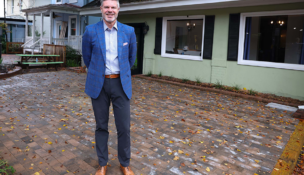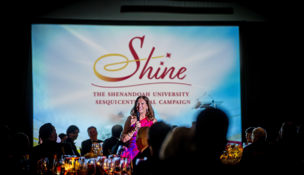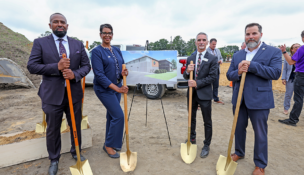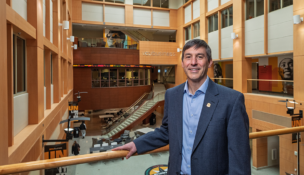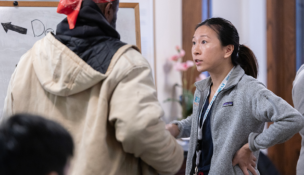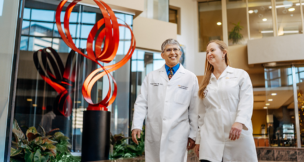Creating a supportive atmosphere
ODU serves a diverse student body
Virginia Business //March 1, 2019//
Creating a supportive atmosphere
ODU serves a diverse student body
Virginia Business //March 1, 2019//
Old Dominion University welcomed the largest freshman class in its history last fall, and its online and transfer enrollment numbers are surging, but officials at the Norfolk-based school say it remains determined to treat its more than 24,300 students as individuals.
With 26 percent of its undergraduates over age 24 and 26 percent attending school part time, ODU realizes a cookie-cutter approach does not lead to academic achievement. Offering 91 bachelor’s, 41 master’s and 22 doctoral degrees, the school prides itself on meeting the needs of a diverse student body.
“We’re becoming more of a destination campus for those in Hampton Roads and beyond, but we individualize how we serve our students,” says Ellen Neufeldt, the university’s vice president for student engagement and enrollment services.
For example, students affiliated with the armed services are plugged into ODU’s Military Connection Center, while online students have campus coaches who regularly touch base with them. Male minority students are encouraged to participate in the campus chapter of Brother 2 Brother, a national mentor organization.
Students enrolled in similar degree programs can join one of the university’s living learning communities. Also, about 1,000 of the university’s more than 3,100 freshmen participate in a student success coaching program in which they explore careers, receive assistance with coursework and are encouraged to make the most of their first year at ODU.
The aim is to create a supportive atmosphere inside and outside the classroom, a key factor in Old Dominion’s growth. In addition to its largest freshman class on record — 3,100 — the university has seen enrollment in STEM programs escalate to the second-highest percentage among Virginia’s doctoral institutions, expanded residential housing and student extracurricular programs and conferred a record number of degrees — more than 4,000 — during last spring’s commencement.
“Along with a wide offering of academic programs, we have a variety of support for students of all ages and backgrounds,” says Jane Dane, ODU’s associate vice president for enrollment management. “Our students recognize that care and support.”
Transfer students

The university recently signed a new transfer agreement with TCC allowing non-traditional students to parlay their work and military experience, knowledge, training and technical skills into college credit and advance their careers. After earning an associate degree in technical studies at TCC, students can transfer into ODU’s industrial technology program in the Darden College of Education to complete their bachelor’s degrees.
Long involved in distance education, ODU, along with George Mason University and the Virginia Community College System, formed the Online Virginia Network. It allows students who left college before completing degrees to finish without setting foot on campus. More than 6,000 ODU students are engaged in online learning. “The concept is to encourage them to return to college and complete their bachelor’s degree and increase the college-educated workforce in Virginia,” Dane says.
Nursing school move
Aside from online learners, most students attend classes at Old Dominion’s Hampton Boulevard campus. The School of Nursing, however, moved to the university’s Virginia Beach Higher Education Center last fall where it plans to increase enrollment and expand clinical labs and simulation spaces. The move brings 850 additional students and 62 faculty members to the center while creating additional synergies with the health-care institutions in the VABeachBio Corridor, such as Sentara Healthcare, Children’s Hospital of The King’s Daughters, LifeNet Health and Operation Smile.
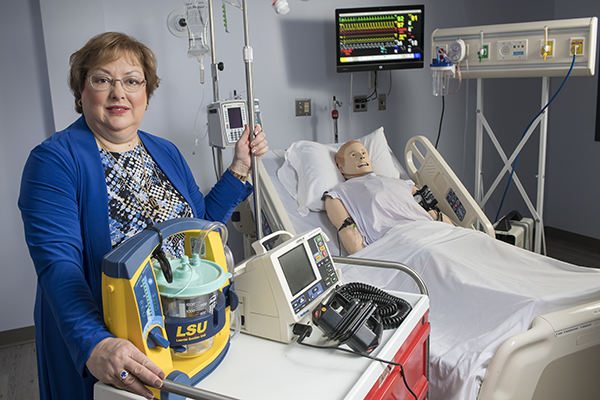
In its new space, the school emphasizes its growing telehealth initiative, using technology to connect health-care providers with patients in remote and underserved areas. “It takes the technology that we all have and uses that to collect and assess data about patients’ conditions and transmit that information to the health-care provider giving guidance for patient care,” Karlowicz explains. “Our graduate students had been receiving training in telehealth, but now, with the new space, telehealth training is being incorporated into the undergraduate curriculum.”
With its plans to open a telehealth education and research center at the Virginia Beach Center, ODU has jumped to the forefront of training in that field. “Very few schools in the U.S. educate students across the board in telehealth,” Karlowicz says. “Our school is very forward thinking. We’re not afraid to try new things. We looked at the future of health care and realized that telehealth is the wave of the future.”
In addition, nursing students and faculty, as well as those in other health-sciences disciplines, may soon be able to treat patients at a university-run health clinic in Virginia Beach. ODU is working with the city to determine the best location for a clinic focusing on underserved populations. “We’re looking at all the options out there,” says Bonnie Van Lunen, dean of the College of Health Sciences. “We want to use it as an education and research center as well as a clinic.”
School of public health?
On its main campus, Old Dominion is awaiting state appropriations to build an $80 million health-sciences facility that would house programs in dental hygiene, medical diagnostic and translational sciences, physical therapy and athletic training, and community and environmental health. The college also plans to implement an occupational-therapy program in the next three to four years to meet the demands of a growing career field.
A school of public health — the first in Virginia — is also on the drawing board. “It’s definitely one of our goals in the next five years,” Van Lunen says. “It would be a community resource and would allow the College of Health Sciences to consolidate program offerings, pursue additional funding opportunities and attract more students and faculty.”
Because of the reputation of its graduates, ODU is a prime location to house public-health programs, Van Lunen adds. “Our students perform their clinicals in Hampton Roads medical facilities, so providers have an opportunity to test drive the students and see the quality of education our students are getting.”
Along with improving health in Hampton Roads, the college’s Center for Global Health has an international focus. It aims to implement innovative educational programs that enhance awareness of global health issues. “The world is changing, and everything is more strongly connected,” says Muge Akpinar-Elci, the center’s director. “If something happens to one country, it impacts other countries.”
The center offers a graduate online certification program in global health, teaching basic health concepts to students in all disciplines, including education, engineering and communications. “For example, we work with engineers to help them understand the health piece so they can find solutions to a country’s drinking water problems,” Akpinar-Elci adds. “It gives them a broader perspective.”
STEM fields
While the College of Health Sciences waits for the green light to begin construction on its new facility, ground was broken this winter for the College of Sciences’ $75.6 million chemistry building. The 110,500-square-foot facility, featuring a 120-seat digital theater, research labs and a planetarium, is projected to be completed in late 2020.
“For students who want to do chemistry, they are not going to find better facilities anywhere,” says Gail Dodge, dean of the college.
Last summer, the National Institutes of Health awarded the college a $1.5 million Maximizing Access to Research Careers (MARC) grant to help underrepresented minority undergraduates in STEM fields pursue biomedical and behavioral sciences research careers. About 33 percent of ODU’s undergraduates are classified as underrepresented, including those in STEM programs.
“This is not the kind of grant any university can get,” Dodge says. “It requires a lot of institutional support, but the college has a robust commitment from the university as well as a diverse campus with a strong minority population.” In addition to increasing opportunities for undergraduate research, Dodge says, ODU also wants to boost the number of minority faculty members in STEM fields.
Providing that encouragement sets Old Dominion apart, Dodge adds. “We have departments at ODU where undergraduate students don’t get lost. They can come here and feel like they’re in a small institutional department where people know them.”
Football stadium renovation
Although most of ODU’s recent construction has focused on academic buildings, the university recently broke ground for the Hugo A. Owens House, a residence hall slated for completion in spring 2020. Named for a local civil rights leader who was the first African-American rector of ODU’s board of visitors, the $62 million project will add 470 beds to the university’s housing inventory. The hall also will include a learning commons area and classrooms, with the majority of residents enrolled in STEM, health, cybersecurity and entrepreneurial programs. “Faculty can come in and conduct courses and interact with students,” says Gregory DuBois, ODU’s vice president for administration and finance.
Meanwhile, contractors are working on an accelerated schedule to renovate the S.B. Ballard Stadium in time for the ODU football team’s home opener on Aug. 31 against Norfolk State University. Funded by private monies, the $67.5 million project will give the 82-year-old facility 21,500 seats, modern amenities and improved traffic flow. “The stadium was past the end of its useful life and didn’t meet the standards when it came to fan comfort,” DuBois notes. “By renovating it in one season, we’re saving about $5 million and avoiding unknown inflation costs and lengthened disruption from construction.”
That scores a win for the university and its growing student population.


